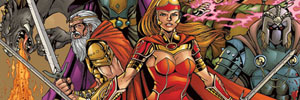Archive for October 5th, 2010
Creating Great Characters Part I
…(Or Why Wolverine is Everywhere)
(Note: This column first appeared last year in Tyler James’ Creating Comics! The Art + Craft column at Comic Related.)
Wolverine has been busy. He’s starred in a summer blockbuster that’s grossed $180 million, ensuring a sequel. He’s got a new ongoing series written by Marvel rising star Jason Aaron, in addition to his other solo books. He’s been mixing it up with Ultimate Hulk in the comics and on DVD. A new Wolvie video game is letting gamers get their berserker rage on. And all this is in addition to his regular duties as a part of the X-Men, X-Force, New Avengers and Lord knows how many other teams. In short, Wolverine is everywhere. But why?
 Today, we focus on the important topic of characters. Creating characters that readers will care about is the hardest task you have as a writer. This goes for comics especially. And for good reason. Think about what you’re asking of the reader for a moment. Whether you are writing comedy, drama, action or suspense, as a writer you are trying to evoke an emotional reaction from your reader. You want to make them care.
Today, we focus on the important topic of characters. Creating characters that readers will care about is the hardest task you have as a writer. This goes for comics especially. And for good reason. Think about what you’re asking of the reader for a moment. Whether you are writing comedy, drama, action or suspense, as a writer you are trying to evoke an emotional reaction from your reader. You want to make them care.
Guess what? Making your readers care is not easy. Think about it, how many times have you listened to a real friend tell you about real problems and thought to yourself, “Meh. You think that’s bad? I once had a hangnail…†Of course, you’d never voice your feelings and probably feigned interest and empathy. That’s what friends are for, right? But truthfully, you weren’t that interested. And these were REAL PEOPLE. With REAL PROBLEMS. As a writer, your challenge is to make readers empathize with your characters, who are MAKE-BELIEVE PEOPLE, with MAKE-BELIEVE PROBLEMS. You have your work cut out for you.
So, how do we do this? How do we go about creating characters that will elicit the emotional responses we want from our readers? First, just acknowledge that there are no guarantees. Not all of your characters are going to resonate with everyone. But there are some things you can do to increase the chances that readers will give a damn about your story people. My thesis here is that the main reason Wolverine is everywhere is that he’s just one hell of a character. And when it comes to comics, character is king.
To help structure this article, I’m going to borrow copiously from Scott McCloud. Scott’s done more thinking about the art form of comics than practically anyone living, and I think he covered characters exceptionally well in his book Making Comics. According to Scott (and ME!) a good comic book character contains the following traits:
1. An Inner Life
2. Visual Distinction
3. Expressive Traits
Let’s take a look at each one of these traits, and apply them to arguably Marvel’s most popular and ubiquitous character over the past 20 years, Wolverine. In Part 1, I’m going to talk about “Inner Life” and “Visual Distinction.” In part II, I’ll cover “Expressive Traits†and share “The Character Grid,†a valuable tool for thinking about the many characters in your stories.

1. An Inner Life- By an inner life, McCloud mean’s that your character should have a unique life history that shapes the character’s world view, determines his desires, and colors her actions. An inner life is more than just “personality.” It’s not enough to say your protagonist is a “tough guy” or “the girl next door.” There needs to be a unifying purpose behind your character, a reason for being. You need to create factors or events in your characters’ lives that give reason for everything they do. This will help you predict how your character will respond to conflicts and action, and is how they’ll start “writing themselves.” The best way to flesh out an inner life is to ask and answer a whole lot of questions about your characters. Who were their parents? Where were they born? What’s the best and worst thing that’s ever happened to them? What secrets do they hold? The more questions you can answer about your character, the more real they’ll become.
Does Wolverine aka Logan have an inner life? Bet your ass he does, Bub. Behind his rough exterior hides a man with so rich a secret past, even he doesn’t know it all. Wolverine is a mutant who possesses animal-keen senses, enhanced physical abilities, retracting bone claws and a healing factor that allows him to recover from any wound (I believe he was tossed into the sun at one point and barely ended up with a sunburn.) He was used by a government program Weapon X, where an indestructable metal was bonded to his skeleton and claws and he was made into a supersoldier. As a parting gift, they also wiped his memory.
That’s just scratching the surface of Wolverine’s 30+ year history in comics, tv, and film, but here is a character with an inner life. And it pays off in the story telling. Tyra Banks’ closet couldn’t fit all the skeletons Logan has in his, and his history often comes into play in his adventures. For example, abuse at the hands of a shady government organization makes Wolverine especially protective of mutant children who are being used and abused. A strong inner life makes Wolverine a character that we can empathize with, and root for when the claws come out.
 2. Visual Distinction – In movies, visual distinction for your characters is important, but not as much as in comics. Sure, Jack Sparrow wouldn’t be half as fun if Johnny Depp and the costume design team didn’t go full on Keith Richards pirate with him. But there are plenty of movies where all you need is an unshaven Bruce Willis’ scowling mug or Jessica Alba in tights to draw a crowd. But in comics, you’re not casting A-list actors who have a history with their audience. You’re creating something new. Comics is a visual medium, and your characters NEED to stand out visually. On the practical, you need to give your characters a unique look so that they stand out from each other.
2. Visual Distinction – In movies, visual distinction for your characters is important, but not as much as in comics. Sure, Jack Sparrow wouldn’t be half as fun if Johnny Depp and the costume design team didn’t go full on Keith Richards pirate with him. But there are plenty of movies where all you need is an unshaven Bruce Willis’ scowling mug or Jessica Alba in tights to draw a crowd. But in comics, you’re not casting A-list actors who have a history with their audience. You’re creating something new. Comics is a visual medium, and your characters NEED to stand out visually. On the practical, you need to give your characters a unique look so that they stand out from each other.
Think of the most popular comic book characters out there. How many of them could you still identify with nothing but a silhouette? A whole bunch, and Wolverine certainly. (Hint: There’s a test for your character designs- black them out. Can you still pick your character out of a lineup? If so, you’re probably heading in the right direction.)
There are plenty of popular artists working in comics today whose male protagonists all look the same. If it wasn’t for costume or color, we’d be clueless who was who. Don’t make that mistake. When designing a character, pay attention to their weight and build and their fashion sense. It also helps if their attire or costume is a visual reminder of their personality. Throw a “Got MILF?” t-shirt on a character in your comic, and it’ll be pretty easy for your audience to recognize, “Hey, that must be the comic relief, Stiffler-guy.”
While Wolverine’s backstory and compelling inner life make him a fun character to write, he wouldn’t be showing up in 20 different Marvel books every month if it wasn’t for this simple fact…He’s damn fun to draw, too! Whether it’s the claws, or the costume, or the muscles, or the sneers, Wolverine just looks cool. And looking cool can take you a long way with a character. Not the whole way, but a long way. Just ask Hugh Jackman, whose career was launched because he bore a strong resemblance to the character and played him well.
Alright, next time we’ll continue to discuss the shared qualities of great characters, and Wolverine in particular. In the meantime, think about some of your favorite characters. Do they in fact have an active and detailed inner life? And are they visually distinct? Then think about the characters you are creating. How can you can you make them even better?









#30Characters Chatter…